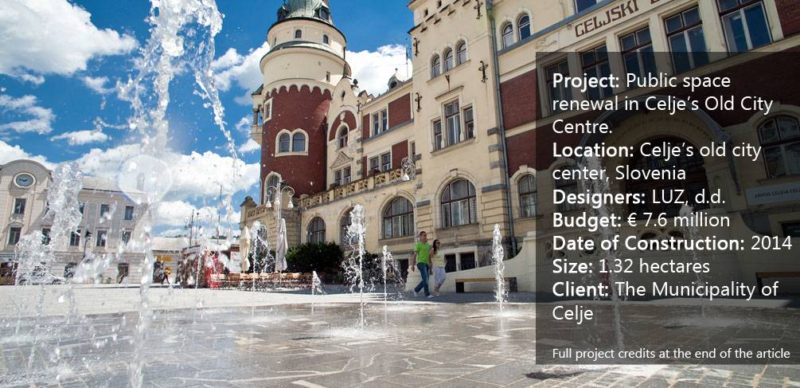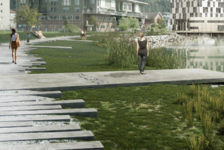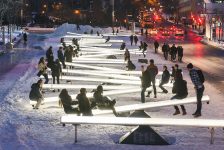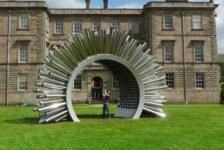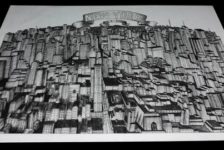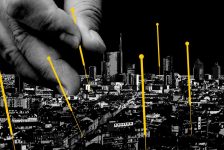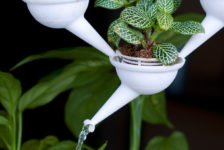Article by Terka Acton Public space renewal in Celje’s Old City Centre, by Darja Matjašec, Sergej Hiti, and Klara Sulič of Ljubljanski urbanistični zavod, d.d. (LUZ), Ljubljana, Slovenia. Cities must adapt if they are to survive. Faced with a shrinking, aging population in its city center, the municipality of Celje resolved to redesign and revive Celje’s open public spaces. For the most recent stage of this work, they engaged Darja Matjašec, Sergej Hiti, and Klara Sulič of LUZ. As landscape architects working in Slovenia, LUZ’s designers are experienced in negotiating the delicate balance between honoring the past and creating spaces for the future. This is something of a Slovenian speciality, as LAN’s Erin Tharp showed in How Velenje Promenada brought light and sunshine back to the city. Celje is Slovenia’s third-largest city. It dates back thousands of years, and its paved streets, imposing castle, and medieval wall fragments reflect this rich history. Today, Celje is an important administrative, commercial, and cultural hub – a status recently boosted by the renewal of public spaces in the historic city center.

Public space renewal in Celje’s Old City Centre. Photo credit: Luka Vidic
Public Space Renewal
The project area includes a total of four public squares in the old city center and two main pedestrian streets connecting them. LUZ’s design for the renewal of Celje’s public spaces was realized in 2014. Building on the Past Archaeologists had expected to find some evidence of earlier times during the renewal work, of course, but they did not anticipate the richness of the finds. These include colonnaded Roman roads and villas with murals, mosaics, and hypocaust (hot air) heating. A stone well discovered at the intersection of the two main pedestrian streets — where it is now displayed — neatly illustrates the layers of the city’s history: Originally constructed in the Middle Ages from fragments of Roman stonework, it had the city’s starred crest and the date “1781” chiselled onto its upper rim, recalling the city’s time as part of the Austro-Hungarian Empire.

Public space renewal in Celje’s Old City Centre. Photo credit: Luka Vidic

Public space renewal in Celje’s Old City Centre. Photo credit: Luka Vidic

Public space renewal in Celje’s Old City Centre. Photo credit: Luka Vidic. Photo credit: Luka Vidic

Public space renewal in Celje’s Old City Centre. Photo credit: Luka Vidic. Photo credit: Luka Vidic

Public space renewal in Celje’s Old City Centre. Photo credit: Luka Vidic. Photo credit: Luka Vidic

Public space renewal in Celje’s Old City Centre. Photo credit: Luka Vidic. Photo credit: Luka Vidic

Public space renewal in Celje’s Old City Centre. Photo credit: Luka Vidic. Photo credit: Luka Vidic

Public space renewal in Celje’s Old City Centre. Photo credit: Luka Vidic. Photo credit: Luka Vidic

Public space renewal in Celje’s Old City Centre. Photo credit: Luka Vidic. Photo credit: Luka Vidic
Full Project Credits For the Public space renewal in Celje’s Old City Centre:
Project Name: Public space renewal in Celje’s Old City Centre Location: Celje’s old city center, Slovenia Budget: € 7.6 million Date of Design: 2011 Date of Construction: 2014 Size: 1.32 hectares / 13,200 square meters Client: The Municipality of Celje Landscape architecture: Darja Matjašec, Sergej Hiti, Klara Sulič / LUZ, d.d. Municipal and energy infrastructure, traffic: LUZ d.d., Elektrosignal d.o.o., Hidroprojekt d.o.o., PIRING s.p., Lespro d.o.o. Lighting design: Arcadia Lightwear Construction: PIRING s.p. Fountain construction: Genera d.o.o. Contractor: Mineral d.o.o with subcontractors Supervision: NAVOR, d.o.o. Photographer: Luka Vidic Recommended Reading:
- Becoming an Urban Planner: A Guide to Careers in Planning and Urban Design by Michael Bayer
- Sustainable Urbanism: Urban Design With Nature by Douglas Farrs
Article by Terka Acton
Published in Blog

